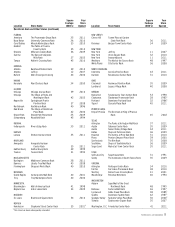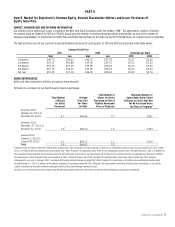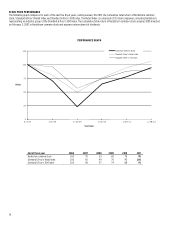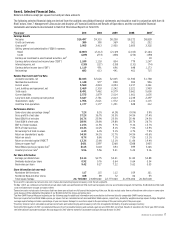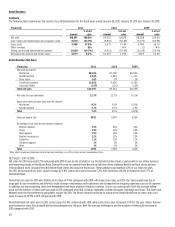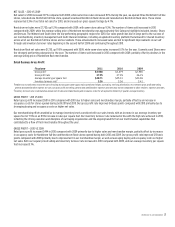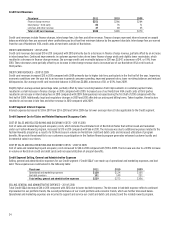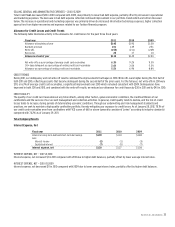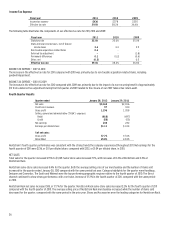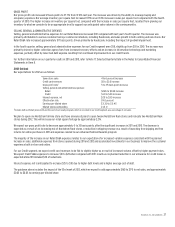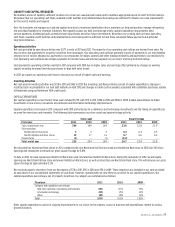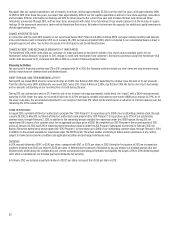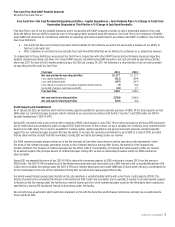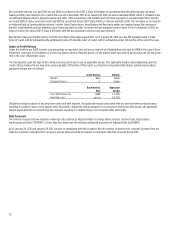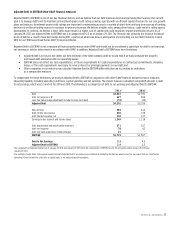Nordstrom 2011 Annual Report Download - page 23
Download and view the complete annual report
Please find page 23 of the 2011 Nordstrom annual report below. You can navigate through the pages in the report by either clicking on the pages listed below, or by using the keyword search tool below to find specific information within the annual report.
Nordstrom, Inc. and subsidiaries 23
Credit Segment
The Nordstrom credit and debit card products are designed to strengthen customer relationships and grow retail sales by providing valuable
services, loyalty benefits and payment products. We believe that owning all aspects of our credit business allows us to fully integrate our rewards
program with our retail stores and provide better service to our customers, thus deepening our relationship with them and driving greater customer
loyalty. Our cardholders tend to visit our stores more frequently and spend more with us than non-cardholders, and we believe the Nordstrom
Fashion Rewards® program helps drive sales in our Retail segment. Our Nordstrom private label credit and debit cards can be used only in Nordstrom
stores and on our website (“inside volume”), while our Nordstrom VISA cards also may be used for purchases outside of Nordstrom (“outside
volume”). Cardholders participate in the Fashion Rewards program, through which they accumulate points based on their level of spending
(generally two points per dollar spent at Nordstrom and one point per dollar spent outside of Nordstrom). Upon reaching two thousand points,
customers receive twenty dollars in Nordstrom Notes®, which can be redeemed for goods or services in our stores or online. Starting in January
2012, all Fashion Rewards customers receive a credit for complimentary alterations and personal triple points days, in addition to early access to
sales events. As part of these changes, Nordstrom Rack is also now included with all bonus points events and the spend requirements for customers
to achieve our two highest benefit levels have been lowered. With increased spending, Fashion Rewards customers can receive additional amounts of
these benefits as well as access to exclusive fashion and shopping events.
The table below provides a detailed view of the operational results of our Credit segment, consistent with the segment disclosure provided in the
Notes to Consolidated Financial Statements. In order to better reflect the economic contribution of our credit and debit card program, intercompany
merchant fees are also included in the table below. Intercompany merchant fees represent the estimated intercompany income of our Credit
segment from the usage of our cards in the Retail segment. To encourage the use of Nordstrom cards in our stores, the Credit segment does not
charge the Retail segment an intercompany interchange merchant fee. On a consolidated basis, we avoid costs that would be incurred if our
customers used third-party cards.
Interest expense is assigned to the Credit segment in proportion to the amount of estimated capital needed to fund our credit card receivables,
which assumes a mix of 80% debt and 20% equity. The average credit card receivable investment metric included in the following table represents
our best estimate of the amount of capital for our Credit segment that is financed by equity. Based on our research, debt as a percentage of credit
card receivables for other credit card companies ranges from 70% to 90%. We believe that debt equal to 80% of our credit card receivables is
appropriate given our overall capital structure goals.
Fiscal year 2011 2010 2009
Amount
% of credit
card
receivables
Amount
% of credit
card
receivables
Amount
% of credit
card
receivables
Credit card revenues $380
18.6%
$390 18.7% $370 17.6%
Interest expense (13)
(0.7%)
(21)
(1.0%) (41)
(2.0%)
Net credit card income 367
17.9%
369 17.7% 329 15.7%
Cost of sales and related buying and
occupancy costs — loyalty program
(75)
(3.7%)
(66)
(3.2%)
(55)
(2.6%)
Selling, general and administrative
expenses
(229)
(11.2%)
(273)
(13.1%)
(356)
(17.0%)
Total expense (304)
(14.9%)
(339)
(16.3%) (411)
(19.6%)
Credit segment earnings (loss) before
income taxes, as presented in
segment disclosure 63
3.1% 30
1.4% (82)
(3.9%)
Intercompany merchant fees 71
3.5%
58 2.8% 50 2.4%
Credit segment contribution (loss),
before income taxes
$134
6.6%
$88
4.2%
$(32)
(1.5%)
Credit and debit card volume:
Outside $4,101
$3,838 $3,603
Inside 3,596
2,953 2,521
Total volume $7,697
$6,791 $6,124
Average credit card receivables $2,047
$2,088 $2,099
Average credit card receivable investment
(assuming 80% of accounts receivable is
funded with debt) $409
$418
$420
Credit segment contribution (loss), net of
tax, as a percentage of average credit
card receivable investment
20.0%
12.8%
(4.7%)


